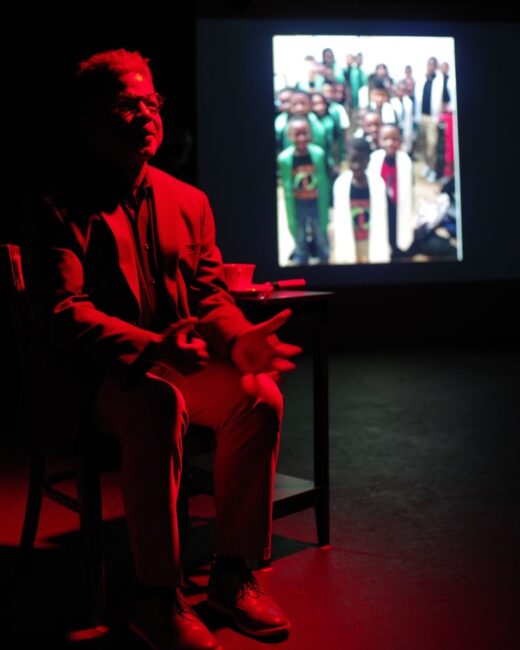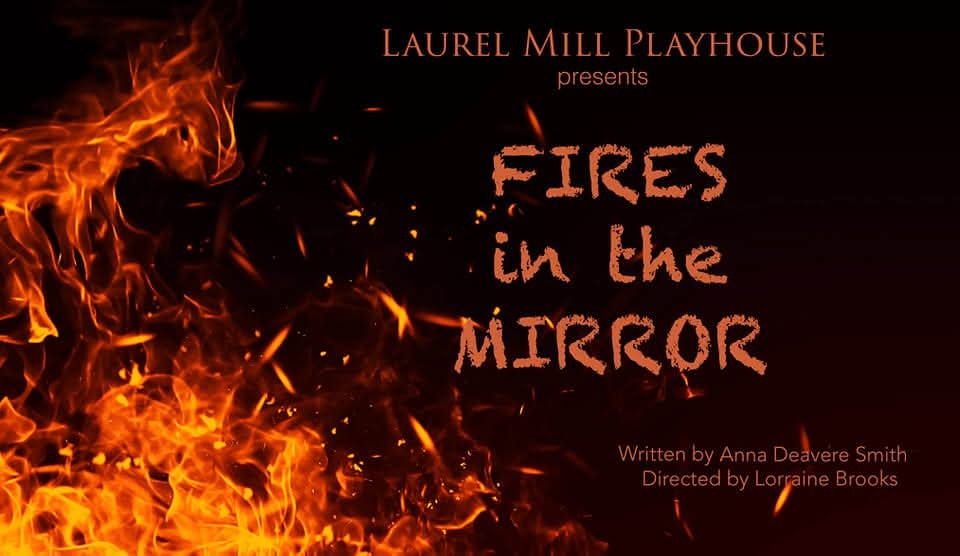author: Chris Pence
The More Things Change: “Fires in the Mirror” at Laurel Mill Playhouse
What defines us, and what defines our views of the world? Is it our race? Gender? Religion? Culture? The community in which we live, or to which we belong? Laurel Mill Playhouse gives us a moment to reflect on these and many more questions in presenting Anna Deavere Smith’s Fires in the Mirror: Crown Heights, Brooklyn, and Other Identities. Composed of twenty-nine monologues constructed from real life accounts, Deavere’s Fires gives a shockingly frank look into the Crown Heights Riot of 1991, reminding the audience of the seldom-remembered tragedy, as well as a reflection into the racial, cultural, and societal issues that still exist in the world some-thirty years after the riots that split in twain a neighborhood whose stitches were already straining.

On August 19th, 1991, an automobile in the three-car motorcade of Rabbi Menachem Mendel Schneerson, leader of the Chabad Lubavitch Hasidic movement in Crown Heights Brooklyn, was struck at the intersection of Utica Avenue and President Street while crossing a red light. The car veered onto the sidewalk, pinning a seven-year-old Black boy named Gavin Cato, and injuring his sister Angela. Cato died instantly due to his injuries. The incident sparked outrage in the community, with Black community members accusing the Jewish community of intentionally killing Cato, and Jewish community members accusing the Black community of antisemitism. A three-day riot ensured, leaving the neighborhood torn to shreds. Jewish student Yankel Rosenbaum was killed shortly after the riot began, in retaliation for the death of Cato.
Fires in the Mirror is a piece of postmodern theatre, aiming to express various points of view rather than the opinions of a single playwright. Director Lorraine Brooks, a New York native who worked in the Brooklyn medical center that cared for Yankel Rosenbaum, has strong personal ties to the events of August 19th, 1991, and brings to the stage these personal connections while helping to develop similar connections in the audience. With the help of Assistant Director Jacqueline Youm and Stage Manager Jana King, Brooks recreates the interviews from the riots with startling realism, essential to truly describe the events of the riots.
Brooks’ minimalistic set for Fires places the focus solely on the performers. A few chairs, a bench, an end table, and some street signs give just enough context to remind the audience of the setting, while using the actors to truly paint the picture. A projection screen with a few short video clips and some tastefully artistic photos from photographers John Cholod and Beth Mills, along with a few music clips between thematic breaks, underscore many of the monologues, leaving the audience to visualize the events for themselves. This generates the theatregoers’ empathy, allowing them to weave their own connections to the story, thanks to Brooks’ light and sound design, and Light and Sound Operator Patrick Pase. The actors take it upon themselves to research and create their characters fully, including hair, costumes, and makeup. Though some characters’ wardrobes come off as more caricature than actuality, their portrayals of the characters more than make up for this indiscretion.
While the show is centered around the Crown Heights riot, the first act hardly mentions the events of the riot, instead addressing ongoing issues plaguing the community in relation to race, culture, and societal issues. Chevell Thomas as George C Wolfe examines themes of Black identity, stating with conviction that “My Blackness doesn’t exist in relationship to your Whiteness.” Rap artist Monique “Big Mo” Matthews (Nessa Amherst) addresses the perceptions and gender bias in the world of hip-hop culture, calling for women to reject their objectification in an art form meant to portray Black culture through rhythm and poetry. Amherst gives modern critics of hip-hop culture a new perspective on what some may see as a controversial form of art. In a discussion of hairstyles across the cultures, An anonymous girl (also played by Amherst) addresses the importance of her racial identity in her school, and how and the girls act, dress, and wear their hair according to the racial groups.
Rivkah Siegal (Ashira Cothron) shows a comparable pattern in the Jewish community, discussing the difficulty behind the Jewish custom of wearing wigs, feeling like the wigs make her fake and not herself. Matthew J. Murray as Minister Conrad Mohammed insists that the black community represents “God’s chosen people,” not the Jewish community, and shocks the audience with claims that the “greatest crime” known to man was not the Holocaust, but the treatment of the black community at the hands of the white community. Lettie Cottin Pogrebin (Marge McGugan) responds to these criticisms with the story of her Uncle Isaac, a Holocaust survivor forced to do the unthinkable to survive. McGugan’s sobs during the monologue left the audience in awe, wondering if the tears were real. An anonymous Lubavitcher woman (Trish Pisarra) followed directly after, lightening the mood with a humorous story about how she asked a young Black boy to turn off a radio on the Sabbath when no one in the family was allowed to do so according to religious law. Pisarra’s bubbly depiction of the Lubavitcher woman allowed for some hope for the neighborhood, as the two cultures came together to solve a problem and laugh about the tiny differences that separated the two peoples.
Act Two started with a rather unconventional dance number. Set to Joe Jackson’s “Target,” and all adorned with bullseye target decals on their chests, the cast came together in interpretive dance to show that, despite the perceived divisions in the community, all members of the community considered themselves threatened by society. Summer Moore’s choreography used traditional storytelling techniques and some unconventional movement to portray both the similarities and differences in the community, and how the community tended to concentrate more on what divided the community rather than that which could bring the community back together.

Following the dance number, the show turned darker, addressing the events of the Crown Heights riots. Following a brief summary of events on the projection screen, the stage lit to find several members of the cast sharing the space in what looked almost like a funeral. A photo of Rosenbaum sat on an easel on stage right, flanked by the Jewish members of the community. On stage left, some street signs and a bench, along with members of the black community. Either community took turns telling their side of the story, offering differing views of what happened that day. Angela Davis (Jacquelin Youm) embraced the metaphor of a rope that was needed to pull the community back together to solve the issue as one. Rabbi Joseph Spielman (Derek Solossi) described the riot events, theorizing that the Black community lied about the events surrounding the death of Cato to start anti-Semitic riots, focusing on the malicious intent of Rosenbaum’s killers.
Segun Olorunyomi appears as Anonymous Young Man #1, claiming that there is no justice for the Black community, and asserting that none of the Jewish population is ever arrested for similar crimes. Roslyn Malamud (Janie Macklin) in turn blames the police and Black leaders for letting the events and crisis get out of control. Yankel Rosenbaum’s brother Norman (Ross Merlin) describes what it was like hearing about his brother’s death for the first time. He later speaks at a rally, wanting justice for his brother’s murder, but believes that the police are not doing all that they can. Anonymous Young Man #2 (Nadia Palacios), argues that, in the community, Black kids have no other choice but to be either athletes or “bad boys.” He says that the Black kid who was blamed for Rosenbaum’s murder was an athlete and therefore would not have killed anyone. Paul Brewster as Rabbi Shea Hecht rejects integration of the community citing the many differences that divide the peoples. Melvin Smith’s Al Sharpton complains about bias in the judicial system and the media. Smith’s fervor in recitation rivaled none but Sharpton himself. Margaret McCabe Janicki (Reuven Ostrov) communicates a similar fear of oppression because she feels that anti-Semitism is everywhere.
Laurel Mill Playhouse’s production of Fires in the Mirror brings honesty and humanity to the horrid events of the Crown Heights riot. Though the show doesn’t offer much of a real conclusion as to who was truly at fault for the accident, it shows a reality much more important than finding fault. Both sides of the community felt victimized by the riots, thanks to the media, misinformation, and scapegoating the others. This proved to settle nothing, and just placed everyone on the defensive, creating more barriers to peace than it tore down. This production shows the audience that violence and hatred is not the answer, and that we all are struggling with our own challenges, many of which mirror those of our apparent enemies. All must work as one community to “break down the wall,” and find the best solution, instead of finding fault in those perceived to be different and using anger as an excuse to hate.
Anna Deavere Smith’s Fires in the Mirror: Crown Heights, Brooklyn, and Other Identities runs February 7th through February 23rd at Laurel Mill Playhouse. Please be aware that the play includes a fair amount of adult language, including racially charged language.
Running Time: 2 hours and 30 minutes with one intermission
Fires in the Mirror plays through February 23rd 2025 at Laurel Mill Playhouse— in the heart of historic Laurel at 508 Main Street in Laurel, MD. Tickets should be purchased in advance (though walk-ins are welcome!) and are available by calling the box office at 301-617-9906 or through the ticketing website online.




